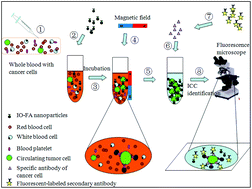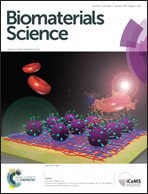Folic acid conjugated magnetic iron oxide nanoparticles for nondestructive separation and detection of ovarian cancer cells from whole blood
Abstract
Because of the lack of early screening strategies, ovarian cancer is the most deadly cause of gynecologic malignancies. This paper describes an effective method for the separation and detection of ovarian cancer cells from female whole blood, using folic acid (FA) conjugated magnetic iron oxide nanoparticles (IO–FA nanoparticles). The IO nanoparticles were synthesized by thermal decomposition and then covalently conjugated with FA. The IO–FA nanoparticles were stably attached to the surface of ovarian cancer cells by coupling to the over-expressed folate receptor (FR), thereby making the cells magnetic. These “magnetic cells” were separated from the complex blood matrix without destruction under a magnetic field. The separation efficiency was as high as 61.3% when the abundance of spiked ovarian cancer SKOV3 cells was as low as 5 × 10−5%. We also successfully detected five (5) out of ten (10) metastatic ovarian cancer patients’ whole blood. This study suggested the feasibility of early detecting of metastatic ovarian cancer cells, which may potentially improve the ovarian cancers patients’ overall survival rate for clinical applications.


 Please wait while we load your content...
Please wait while we load your content...